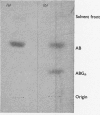Abstract
1. Bilirubin glucuronide was synthesized in vitro in a system containing a rat liver microsomal fraction, UDP-glucuronic acid, Mg2+ and bilirubin. The enzymic synthesis was accomplished without the addition of a bilirubin carrier. 2. Azobilirubin and azobilirubin glucuronide were separated by t.l.c. and paper chromatography and the measurement of the conjugate provided a specific assay for bilirubin UDP-glucuronyltransferase (EC 2.4.1.17). 3. This diazo compound was labelled when [U-14C]UDP-glucuronic acid was employed in the transglucuronidation reaction. 4. Identity of the glucuronide nature of the product was further confirmed by hydrolysis with β-glucuronidase prepared from limpets and Helix pomatia. In each instance azobilirubin and glucuronic acid were liberated. 5. There was a close correlation between the bilirubin glucuronyl-transferase activity as measured by two procedures, colorimetric and radioisotopic. The specific activities so measured were 19nmol of bilirubin `equivalents' conjugated/h per mg of protein and 16.9–18.4nmol of UDP-glucuronic acid incorporated/h per mg of protein, respectively. On this basis, it was concluded that the major product formed in vitro was bilirubin monoglucuronide; this represents about 77% of the total products formed. 6. The Km values for bilirubin and UDP-glucuronic acid at pH8.2 are 3.3×10−4m and 1.67×10−3m, respectively. 7. The addition of Mg2+ at a final concentration of 5mm to the reaction mixture increased the rate of conjugation by 5.6-fold in the microsomal preparation that had been subjected to overnight dialysis against 10mm-EDTA (disodium salt). 8. Diethyl-nitrosamine at a final concentration of 1–20mm has no effect on the glucuronidation of bilirubin in vitro.
Full text
PDF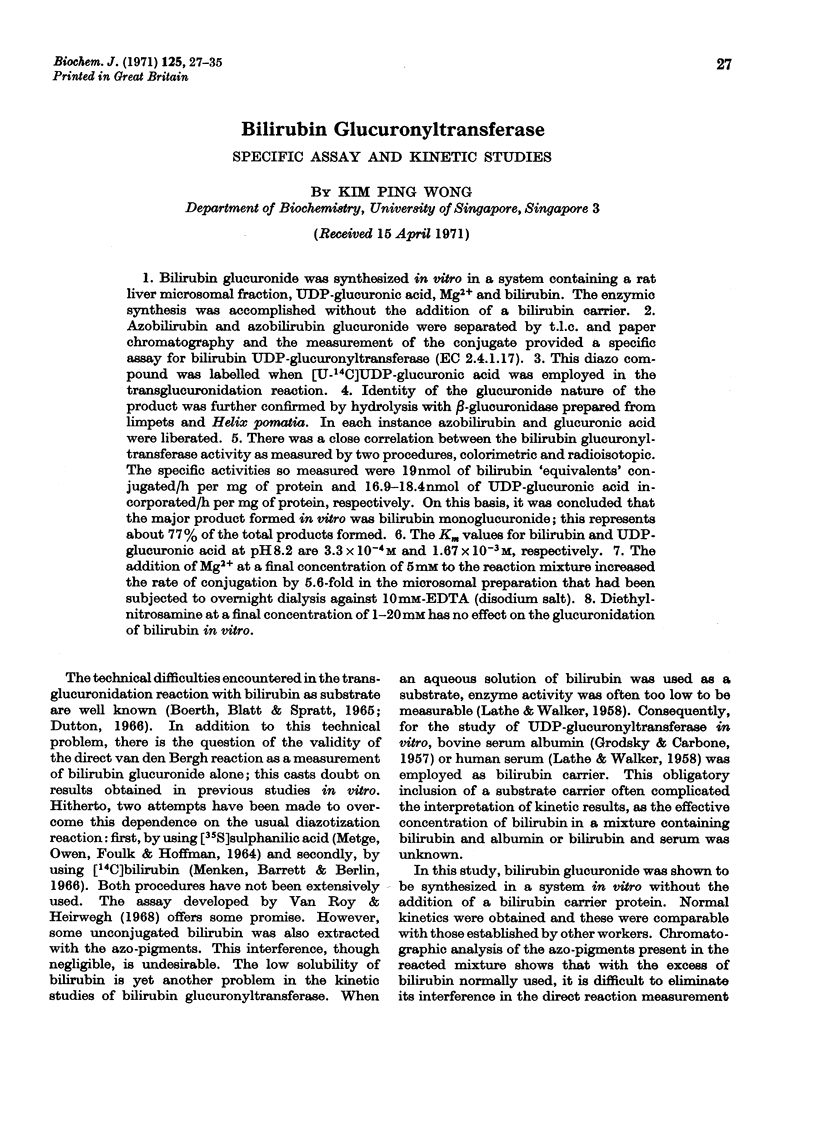
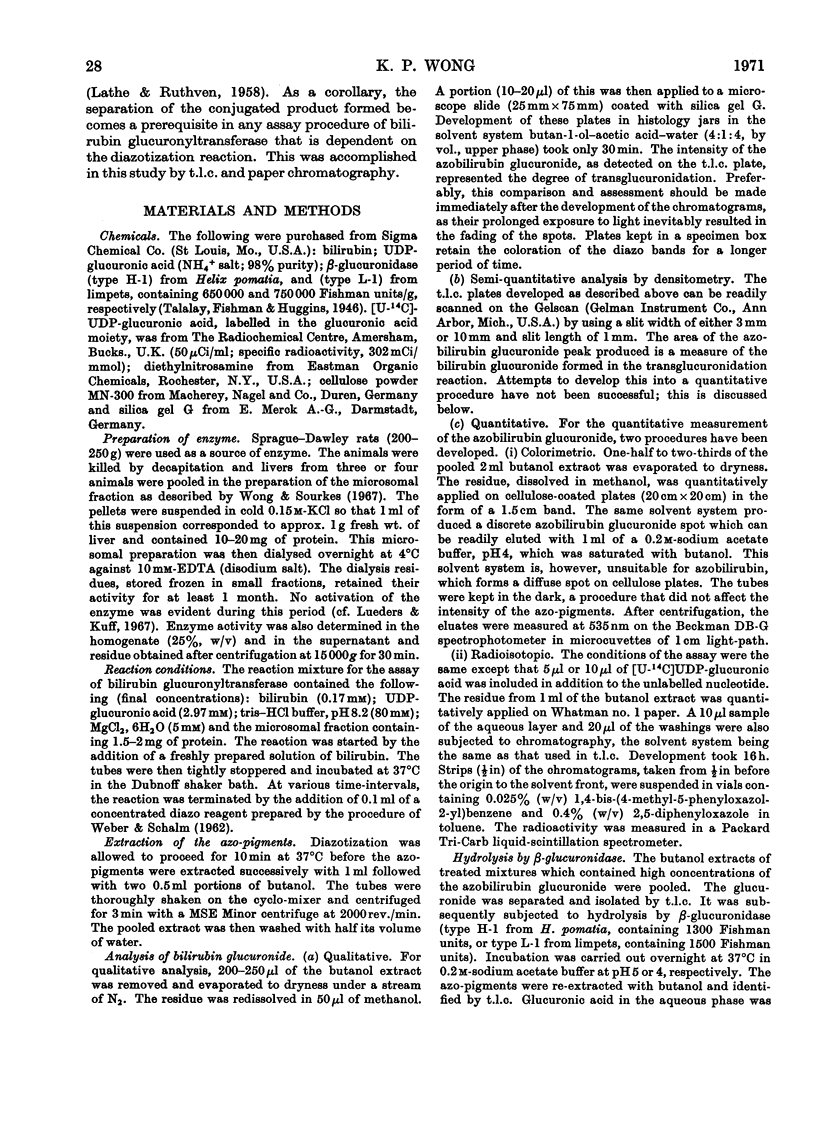
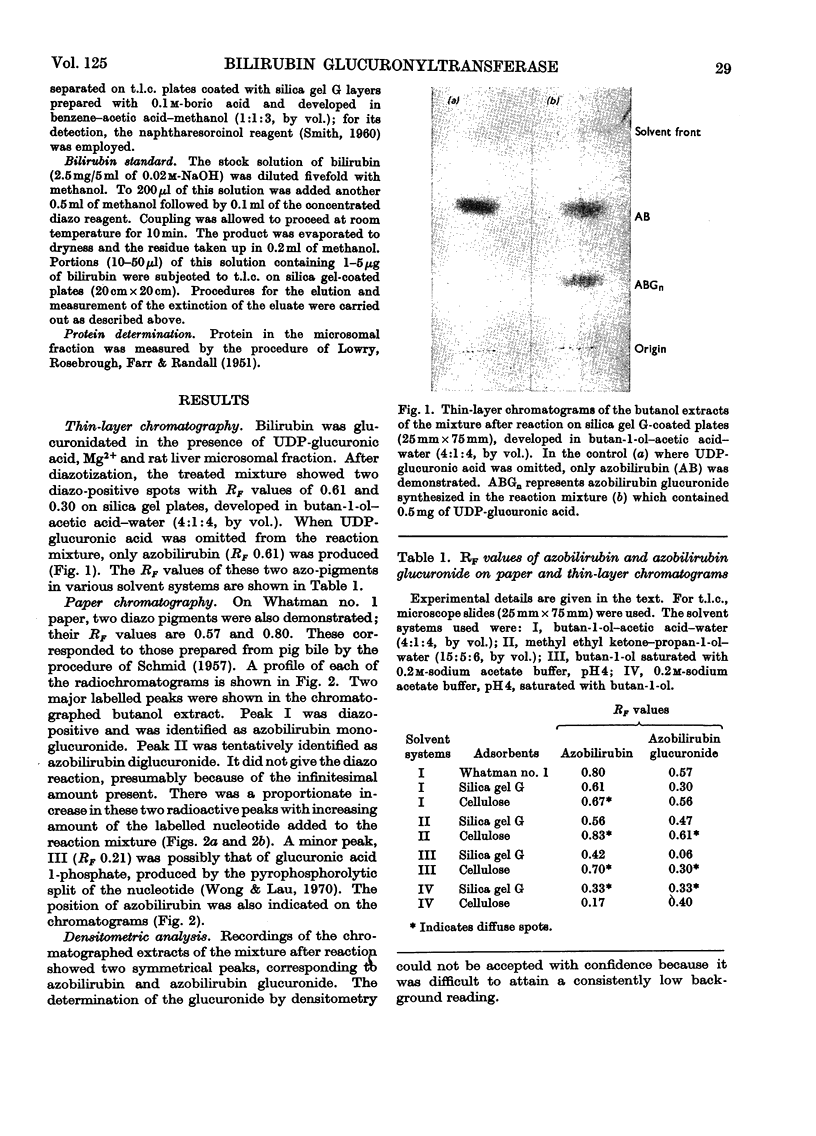
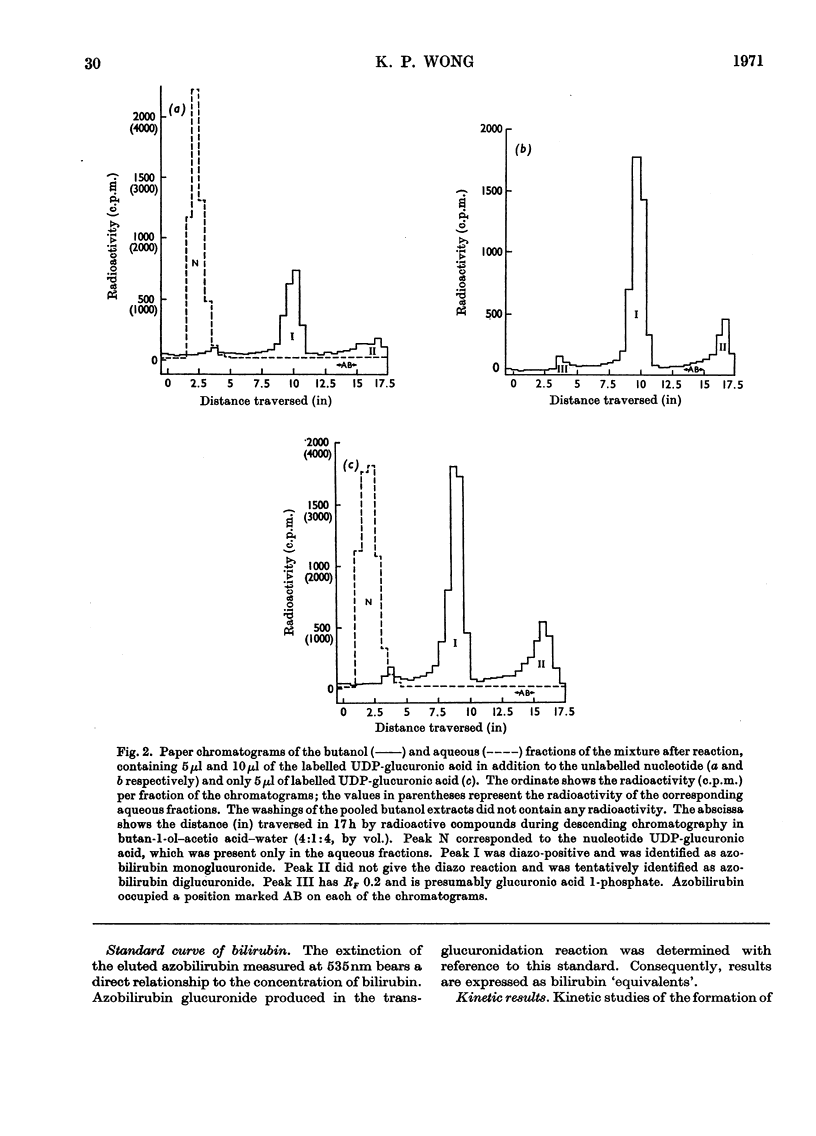
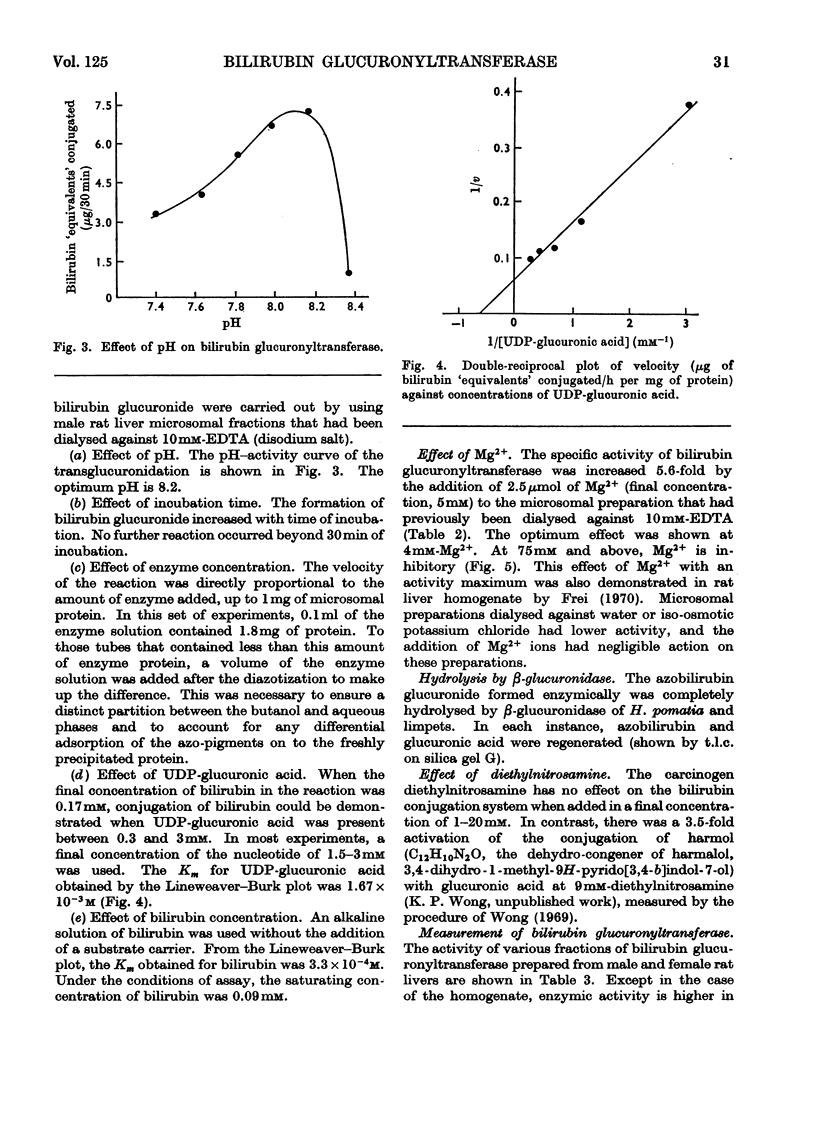
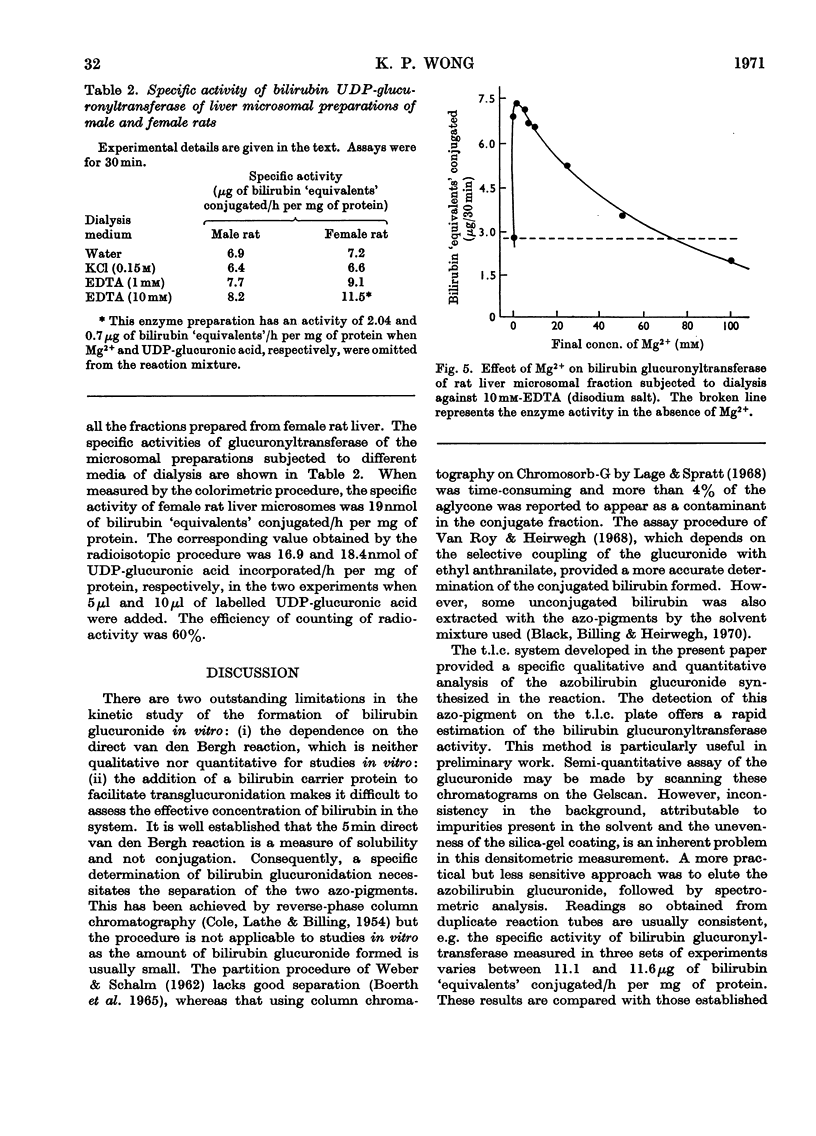
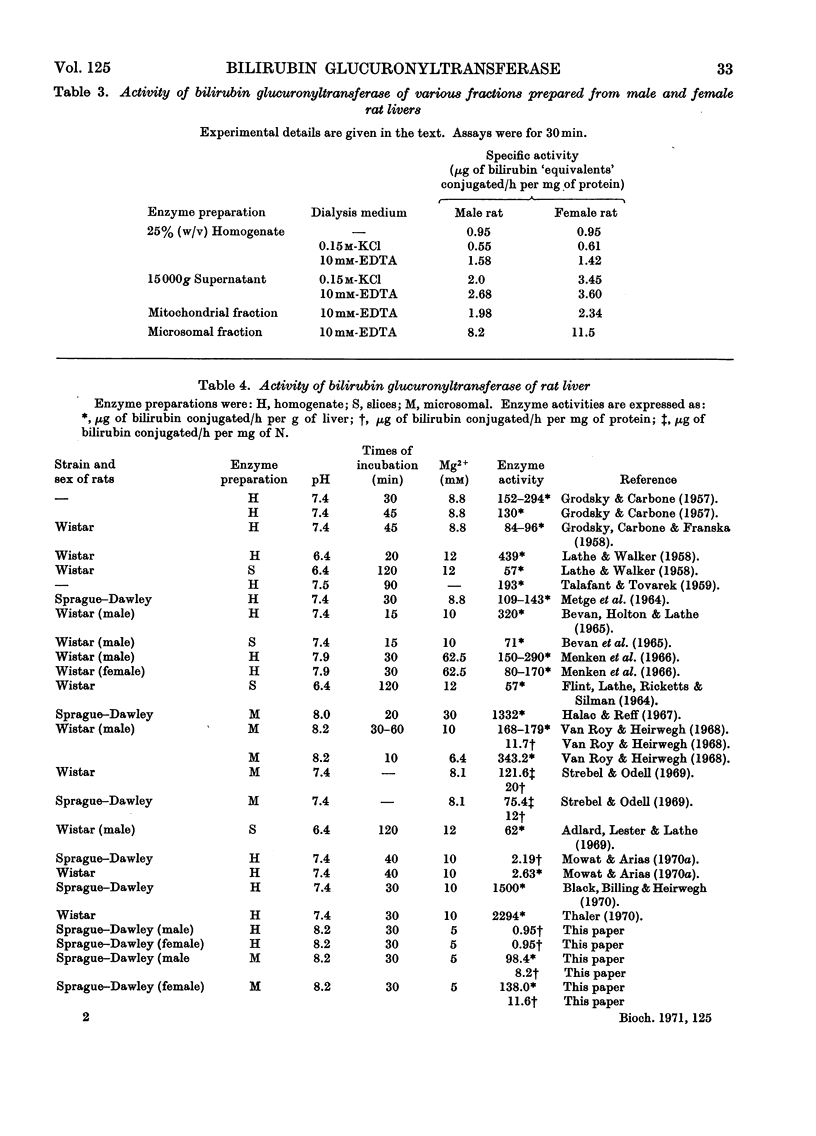
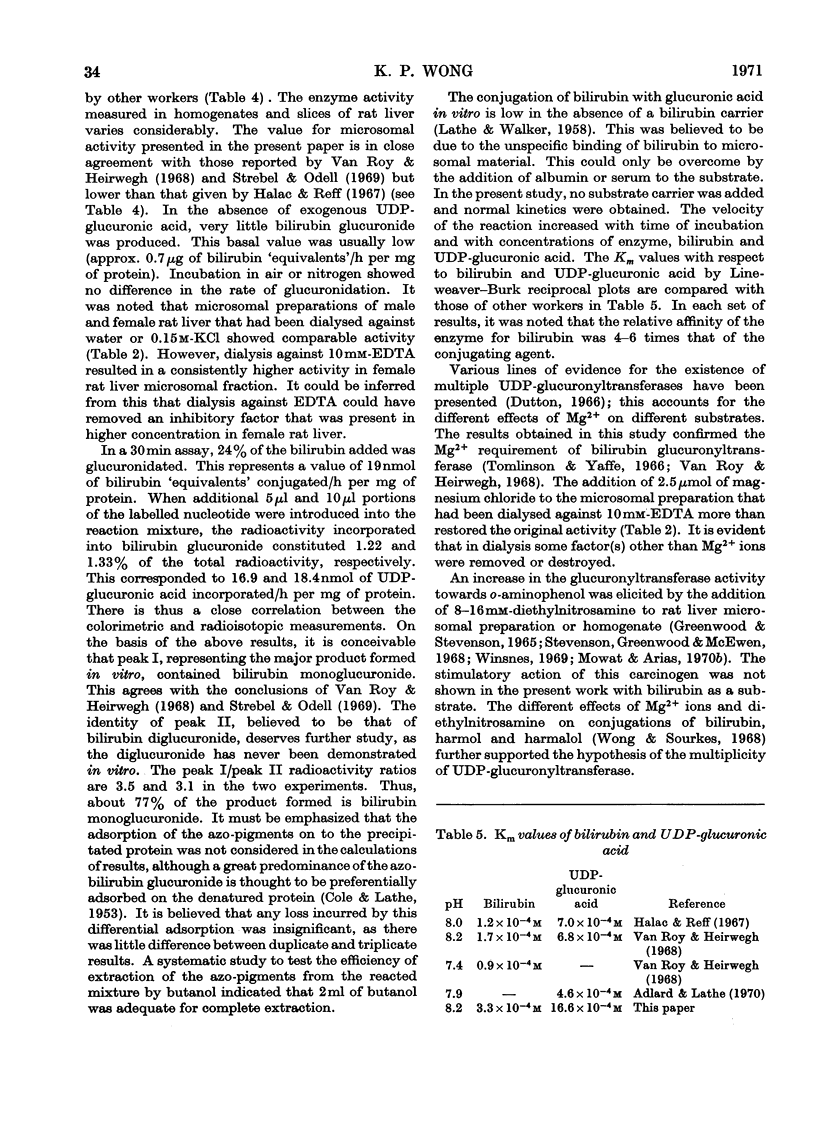

Images in this article
Selected References
These references are in PubMed. This may not be the complete list of references from this article.
- Adlard B. P., Lathe G. H. The effect of steroids and nucleotidesoon solubilized bilirubin uridine diphosphate-glucuronyltransferase. Biochem J. 1970 Sep;119(3):437–445. doi: 10.1042/bj1190437. [DOI] [PMC free article] [PubMed] [Google Scholar]
- Adlard B. P., Lester R. G., Lathe G. H. The effect of phenobarbitone treatment of rats and of protein deprivation on the capacity of liver slices to conjugate bilirubin. Biochem Pharmacol. 1969 Jan;18(1):59–63. doi: 10.1016/0006-2952(69)90009-4. [DOI] [PubMed] [Google Scholar]
- BOERTH R. C., BLATT A. H., SPRATT J. L. LIMITATIONS IN THE DETERMINATION OF IN VITRO BILIRUBIN GLUCURONIDE FORMATION. J Lab Clin Med. 1965 Mar;65:475–483. [PubMed] [Google Scholar]
- Bevan B. R., Holton J. B., Lathe G. H. The effect of pregnanediol and pregnanediol glucuronide on bilirubin conjugation by rat liver slices. Clin Sci. 1965 Oct;29(2):353–361. [PubMed] [Google Scholar]
- COLE P. G., LATHE G. H., BILLING B. H. Separation of the bile pigments of serum, bile and urine. Biochem J. 1954 Jul;57(3):514–518. doi: 10.1042/bj0570514. [DOI] [PMC free article] [PubMed] [Google Scholar]
- COLE P. G., LATHE G. H. The separation of serum pigments giving the direct and indirect van den Bergh reaction. J Clin Pathol. 1953 May;6(2):99–104. doi: 10.1136/jcp.6.2.99. [DOI] [PMC free article] [PubMed] [Google Scholar]
- Frei J. Multiplicity and specificity of UDP-glucuronyltransferase. I. Effect of divalent cations and EDTA on the activity of UDP-glucuronyltransferase assayed with bilirubin, 4-methylumbelliferone and p-nitrophenol. Enzymol Biol Clin (Basel) 1970;11(5):385–401. [PubMed] [Google Scholar]
- GRODSKY G. M., CARBONE J. V., FANSKA R. Enzymatic defect in metabolism of bilirubin in fetal and newborn rat. Proc Soc Exp Biol Med. 1958 Feb;97(2):291–294. doi: 10.3181/00379727-97-23719. [DOI] [PubMed] [Google Scholar]
- GRODSKY G. M., CARBONE J. V. The synthesis of bilirubin glucuronide by tissue homogenates. J Biol Chem. 1957 May;226(1):449–458. [PubMed] [Google Scholar]
- Halac E., Jr, Reff A. Studies on bilirubin UDP-glucuronyltransferase. Biochim Biophys Acta. 1967 Jul 11;139(2):328–343. doi: 10.1016/0005-2744(67)90036-8. [DOI] [PubMed] [Google Scholar]
- LATHE G. H., RUTHVEN C. R. Factors affecting the rate of coupling of bilirubin and conjugated bilirubin in the van de Bergh reaction. J Clin Pathol. 1958 Mar;11(2):155–161. doi: 10.1136/jcp.11.2.155. [DOI] [PMC free article] [PubMed] [Google Scholar]
- LATHE G. H., WALKER M. The synthesis of bilirubin glucuronide in animal and human liver. Biochem J. 1958 Dec;70(4):705–712. doi: 10.1042/bj0700705. [DOI] [PMC free article] [PubMed] [Google Scholar]
- LOWRY O. H., ROSEBROUGH N. J., FARR A. L., RANDALL R. J. Protein measurement with the Folin phenol reagent. J Biol Chem. 1951 Nov;193(1):265–275. [PubMed] [Google Scholar]
- Lage G. L., Spratt J. L. Bilirubin conjugation by hepatic microsomes from adult male guinea pigs. Arch Biochem Biophys. 1968 Jul;126(1):175–180. doi: 10.1016/0003-9861(68)90571-7. [DOI] [PubMed] [Google Scholar]
- Lueders K. K., Kuff E. L. Spontaneous and detergent activation of a glucuronyltransferase in vitro. Arch Biochem Biophys. 1967 Apr;120(1):198–203. doi: 10.1016/0003-9861(67)90614-5. [DOI] [PubMed] [Google Scholar]
- METGE W. R., OWEN C. A., Jr, FOULK W. T., HOFFMANN H. N., 2nd BILIRUBIN GLUCURONYL TRANSFERASE ACTIVITY IN LIVER DISEASE. J Lab Clin Med. 1964 Jul;64:89–98. [PubMed] [Google Scholar]
- Mowat A. P., Arias I. M. Observations of the effect of diethylnitrosamine on glucuronide formation. Biochim Biophys Acta. 1970 Jul 15;212(1):175–178. doi: 10.1016/0005-2744(70)90192-0. [DOI] [PubMed] [Google Scholar]
- SCHMID R. The identification of direct-reacting bilirubin as bilirubin glucuronide. J Biol Chem. 1957 Dec;229(2):881–888. [PubMed] [Google Scholar]
- Stevenson I., Greenwood D., McEwen J. Hepatic UDP-glucuronyltransferase in Wistar and Gunn rats--in vitro activation by diethylnitrosamine. Biochem Biophys Res Commun. 1968 Sep 6;32(5):866–872. doi: 10.1016/0006-291x(68)90321-5. [DOI] [PubMed] [Google Scholar]
- TALAFANT E., TOVAREK J. Factors affecting the rate of bilirubin conjugation in vitro. Nature. 1959 Jan 10;183(4654):111–112. doi: 10.1038/183111b0. [DOI] [PubMed] [Google Scholar]
- Thaler M. M. Substrate-induced conjugation of bilirubin in genetically deficient newborn rats. Science. 1970 Oct 30;170(3957):555–556. doi: 10.1126/science.170.3957.555. [DOI] [PubMed] [Google Scholar]
- Tomlinson G. A., Yaffe S. J. The formation of bilirubin and p-nitrophenyl glucuronides by rabbit liver. Biochem J. 1966 May;99(2):507–512. doi: 10.1042/bj0990507. [DOI] [PMC free article] [PubMed] [Google Scholar]
- Van Roy F. P., Heirwegh K. P. Determination of bilirubin glucuronide and assay of glucuronyltransferase with bilirubin as acceptor. Biochem J. 1968 Apr;107(4):507–518. doi: 10.1042/bj1070507. [DOI] [PMC free article] [PubMed] [Google Scholar]
- WEBER A. P., SCHALM L. Quantitative separation and determination of bilirubin and conjugated bilirubin in human serum. Clin Chim Acta. 1962 Nov;7:805–810. doi: 10.1016/0009-8981(62)90063-3. [DOI] [PubMed] [Google Scholar]
- Winsnes A. Studies on the activation in vitro of glucuronyltransferase. Biochim Biophys Acta. 1969 Nov 4;191(2):279–291. doi: 10.1016/0005-2744(69)90247-2. [DOI] [PubMed] [Google Scholar]
- Wong K. P. A new fluorometric assay of beta-glucuronidase in tissues and serum. Anal Biochem. 1970 May;35(1):35–45. doi: 10.1016/0003-2697(70)90006-0. [DOI] [PubMed] [Google Scholar]
- Wong K. P., Sourkes T. L. Determination of UDPG and UDPGA in tissues. Anal Biochem. 1967 Dec;21(3):444–453. doi: 10.1016/0003-2697(67)90319-3. [DOI] [PubMed] [Google Scholar]
- Wong K. P., Sourkes T. L. Glucuronidation of 3-O-methylnoradrenaline, harmalol and some related compounds. Biochem J. 1968 Nov;110(1):99–104. doi: 10.1042/bj1100099. [DOI] [PMC free article] [PubMed] [Google Scholar]



